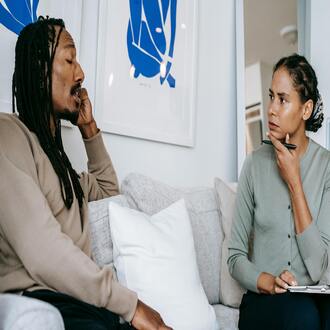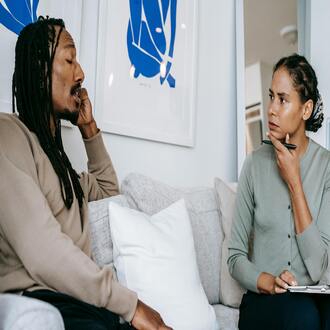Transcription Planning the first session (I)
Coaching begins with the first meeting between the client and the coach. This is where the rapport between the two is built, where the foundation of mutual trust is laid and where the coach's work begins. This meeting sets the stage, deals with the practical details of how the coaching will work, explores the client's current situation and sets the tone for future work.
This first meeting consists of the following phases:
- Laying the groundwork for mutual trust.
- Gathering and evaluating information about the client.
- Discover the client's expectations.
- Determine the client's concerns.
- Plan a coaching partnership.
- Hold both parties accountable to the program.
- Address the most immediate issue.
Lay the foundation for mutual trust
Syntony means mutual respect and influence. There is only one chance to make a first impression, but attunement can be established at any time and comes from trying to understand the other on their terms, to see the world from their point of view, to imagine you are in their shoes. It is not friendship, but a willingness to be open. It does not mean being in agreement, you can be in total disagreement and be in tune with the other.
It is not an exclusive all-or-nothing quality, there are various degrees of attunement and when it is maintained over time, it leads to trust. If nothing is done to interfere with it, it can be established on many levels. Attunement is natural.
Respect for values and beliefs:
- It is important to respect the beliefs and values of the coachee, not necessarily by agreeing with him, but by trying to see things from his point of view and to undertake the coaching action with curiosity and willingness to modify that perspective. Otherwise, you would only end up coaching people who are similar in terms of values and beliefs and/or trying to make them even more like you.
- You may or may not agree with what the client has done, but that does not prevent you from accepting and respecting what they did according to their circumstances. If respect for the beliefs and values of the coachee is not achieved, then it is preferable not to take it. The coach also has the right to have and respect his own limits.
Match the behavior:
- Videos of people with good rapport demonstrate the existence of a kind of dance in body language. One person makes a gesture and a few seconds later the other makes a similar gesture. The two tend to move at the same pace and at the same speed. Their body language becomes equal. William Condon called this phenomenon Cultural Microrhythms.
- The same is true of tone of voice. Those who enjoy a good relationship tend to speak at the same speed and volume, also the latency period. Even when they have a very intimate relationship they may breathe in unison.
- That is attunement in the behavioral aspect. It has to come from a sincere desire to enter into the other's model of the world and understand him or her. Then it becomes easy, powerful and natural.
- Attention must be paid to the client's behavior. If he is standing, stay standing, move at the same pace, match his degree of eye contact. Try to have the same tone and volume of voice, identify the amount of space you need.
- Then the client unconsciously understands that you are sincerely trying to enter their world and they will begin to feel comfortable.
- Matching is not imitating, it is not about meticulously copying the client's movements, as in that case the effect would be the opposite of the desired one. He will start to feel uncomfortable.
- When you are in disagreement with the client, it is good to make sure to match his movements and tone of voice, these gestures and also the voice, will indicate to the client that you still respect and understand him.
In the first meeting start by matching:
- Posture in general.
- Speed of movement.
- Eye contact.
- Speech speed.
- Voice volume.
If you see that the session is not going well, focus less on what you say and more on matching body and voice.
Match words:
- People's words reflect their thoughts and these, in turn, reflect their reality. That is why it is necessary to take note of the important words or phrases the coachee uses for his or her values and the way he or she emphasizes them. Using the same words on the part of the coach makes the client perceive that attention is being paid to what he feels and what matters to him. This is called backtracking or recapitulation.
- Paraphrasing does not prove understanding, as the coach uses his own words and reflects his own reality, even though it may sometimes resemble the client's.
- By recapitulating you rephrase in your own words the key points for the client and even match their gestures.
Recapping is useful at all stages of coaching if you wish:
- Check that you and your client are in agreement.
- Build and demonstrate rapport by giving evidence that you are really listening.
- Avoid misunderstandings.
- Clarify the client's values.
Recapping is simple and effective. But, as with matching body language, be respectful and match only what is important otherwise the client will think: Why is the coach repeating what I say?
Match the thinking:
- Thinking is something different for each person. In our mind we hear, see and feel exactly the same as in the outside world with our senses (sight, hearing, sensations, smell and taste), i.e. we re-experience the world through them. The senses used internally are called representational systems.
- The representation system is usually linked to a particularly preferred or developed sensory channel. For all this, we must pay attention to the words the client uses, since words dress our thoughts, they give away our mental origins.
- For example: When a client says "I see what you mean", he is building a visual image. If he says "Let's see how this idea sounds to you", he is thinking in terms of sounds or words and if he tells you that he "can't take charge of his life", he is thinking through the kinesthetic system of representation.
- Each system has its own language of sense-based idioms. Eye movement can be a way to perceive how the client thinks, even if you don't know what they think. For example, if someone thinks with their kinesthetic system, they will tend to look down and to their right. If he is talking to himself, then the eyes move down to the left, if he is visualizing they move up without focusing.
So, the good coach needs to develop three skills:
- Pay attention to words and description. The concept is slippery because we are used to interpreting what we are told, not how we are told.
- Establish the connection between the words used by the client and the representation system he/she uses.
- Respond with words specific to that same representational system. The exact words matter. When it does, the client unconsciously perceives that they understand you at a deep level.
Pleasant environment:
- Attunement is easier in a pleasant environment, it is desirable to have a welcoming room. Make sure that calls, emails or visitors are not disturbing.
- Turn off your cell phone. The client has to feel that this space is as much yours as theirs. You will be judged by your attire and your appearance. Although it may seem superficial, that's how it happens, so it's worth paying attention to this aspect.
Gaining confidence: Confidence takes time. To do this you need to demonstrate some qualities right from the first session:
- Be authentic.
- Be sincere.
- Be competent.
- Be honest.
- To be coherent.
- Be present.
Gather and evaluate information about the customer
Initial information: Just at the first contact, if not before, it is necessary to obtain basic information about the customer, being advisable to have even a printed questionnaire:
- Name.
- Address.
- Landline telephone number.
- Cell phone number.
- Fax number.
- E-mail address.
- Web page.
If the client is an employee, it is also necessary to know:
- Company name and address.
- Telephone number.
- Fax number.
- E-mail address.
- Web site.
The customer:
- Here are some key issues to talk to the client about. The areas you will focus on will depend on the kind of coaching you are going to do with them, as well as the issue that is most pressing to them.
- Next, let's look at some issues that you probably won't address directly with your client, but that touch on areas you'll need to know about to do your coaching properly. Where appropriate, you can explore these throughout the coaching relationship.
Career:
- What does the client do?
- How does he feel about his work?
- What is his or her interest in his or her work?
- What has he done to protect his career?
- What is he doing to develop it?
- Does he feel stuck?
- Do you have any regrets?
- Does your job provide you with the income you need?
Relationships: The quality of relationships reflects the client's quality of life and happiness:
- What kind of relationships does the client have?
- Is he/she married?
- Does he/she have a family?
- Does he/she have many close friends?
- With whom does he/she feel closest?
- Does he/she feel happy with his/her relationships?
Health and energy: Physical condition and energy level is important:
- How is your health?
- What do you do to maintain your health?
- Are you concerned about your health?
- Do you feel well?
- How is your energy level?
Financial situation:
- How do you feel about money?
- Are you satisfied with what you earn?
- Do you have savings to meet any unexpected crises?
- How do you take care of your financial security?
Objects and values:
- What do you expect from life?
- Wha
planning first session i




